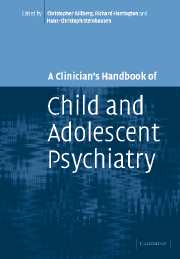Book contents
- Frontmatter
- Contents
- Preface
- List of contributors
- 1 Brain disorders
- 2 Substance use disorders
- 3 Schizophrenia and schizophrenia-like disorders
- 4 Affective disorders
- 5 Anxiety disorders
- 6 Obsessive-compulsive disorders
- 7 Adjustment disorders
- 8 Post-traumatic stress disorder
- 9 Functional somatic symptoms and somatoform disorders in children
- 10 Eating disorders: anorexia nervosa and bulimia nervosa
- 11 Sleep disorders
- 12 Personality disorders
- 13 Mental retardation/learning disability
- 14 Specific developmental disorders of speech and language
- 15 Reading and other learning disorders
- 16 Autism spectrum disorders
- 17 Hyperkinetic disorders
- 18 Conduct disorders
- 19 Elective mutism
- 20 Attachment and disorders of attachment
- 21 Tic disorders
- 22 Elimination disorders: enuresis and encopresis
- 23 Physical and sexual abuse
- 24 Gender identity disorders
- Index
- References
24 - Gender identity disorders
Published online by Cambridge University Press: 06 August 2009
- Frontmatter
- Contents
- Preface
- List of contributors
- 1 Brain disorders
- 2 Substance use disorders
- 3 Schizophrenia and schizophrenia-like disorders
- 4 Affective disorders
- 5 Anxiety disorders
- 6 Obsessive-compulsive disorders
- 7 Adjustment disorders
- 8 Post-traumatic stress disorder
- 9 Functional somatic symptoms and somatoform disorders in children
- 10 Eating disorders: anorexia nervosa and bulimia nervosa
- 11 Sleep disorders
- 12 Personality disorders
- 13 Mental retardation/learning disability
- 14 Specific developmental disorders of speech and language
- 15 Reading and other learning disorders
- 16 Autism spectrum disorders
- 17 Hyperkinetic disorders
- 18 Conduct disorders
- 19 Elective mutism
- 20 Attachment and disorders of attachment
- 21 Tic disorders
- 22 Elimination disorders: enuresis and encopresis
- 23 Physical and sexual abuse
- 24 Gender identity disorders
- Index
- References
Summary
Gender identity disorder: general aspects
Introduction
A newborn does not yet have self-awareness of his or her sex and gender. Such self-awareness evolves gradually in early childhood. Children learn to make consistent and systematic use of genital information as a criterion for the classification of their own and other's sex. Interestingly, long before they do so, they appear to have knowledge about gender stereotypes and display either female or male gender role behaviour. Toy and game preferences as well as preferences for same-sex peers are expressed much earlier than a complete understanding of the various aspects of gender is reached.
Nature as well as nurture play important parts in the shaping of gender role behaviour. Adults and children influence gender development directly by reinforcing or discouraging sex-typed behaviours and indirectly by offering role models. However, from animal and human research, it has been found that sex hormones also play a significant role in the development of sex-typed behaviour and characteristics.
In most cases, sex, gender identity and gender role usually develop in accordance with each other. Sometimes a discrepancy exists between gender identity and role, and biological sex. Parents or children who are confronted with such a divergence often seek professional help. Because the issues in the management of gender identity problems are very different when dealing with children than when dealing with adolescents we will discuss the clinical management of both age groups separately.
- Type
- Chapter
- Information
- A Clinician's Handbook of Child and Adolescent Psychiatry , pp. 695 - 725Publisher: Cambridge University PressPrint publication year: 2006
References
- 8
- Cited by



